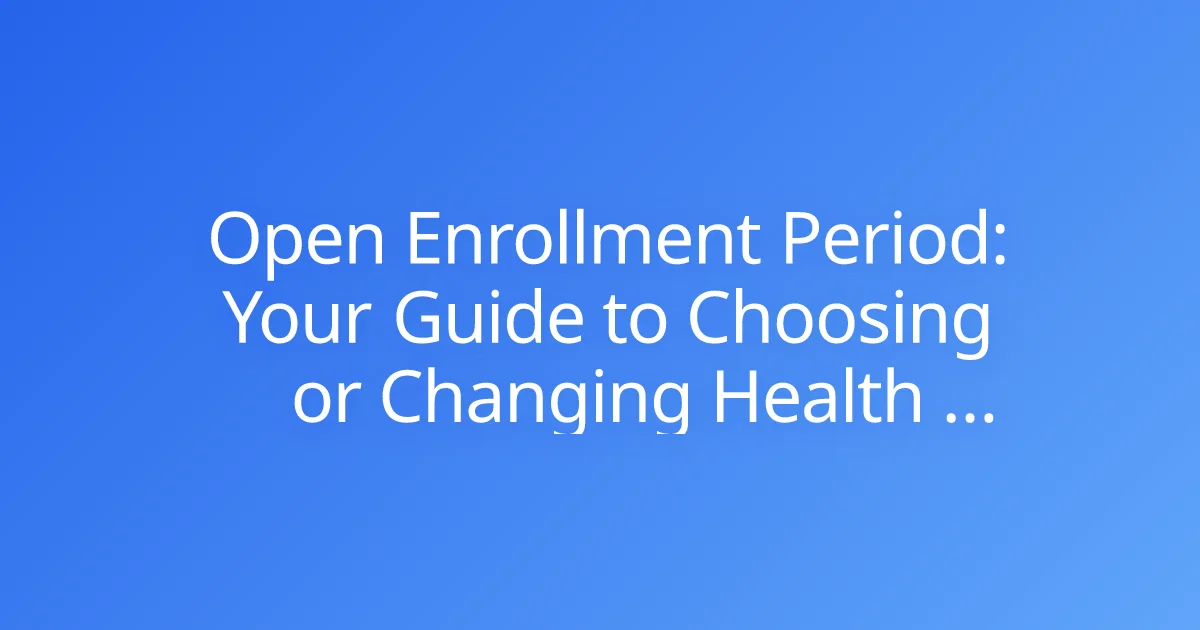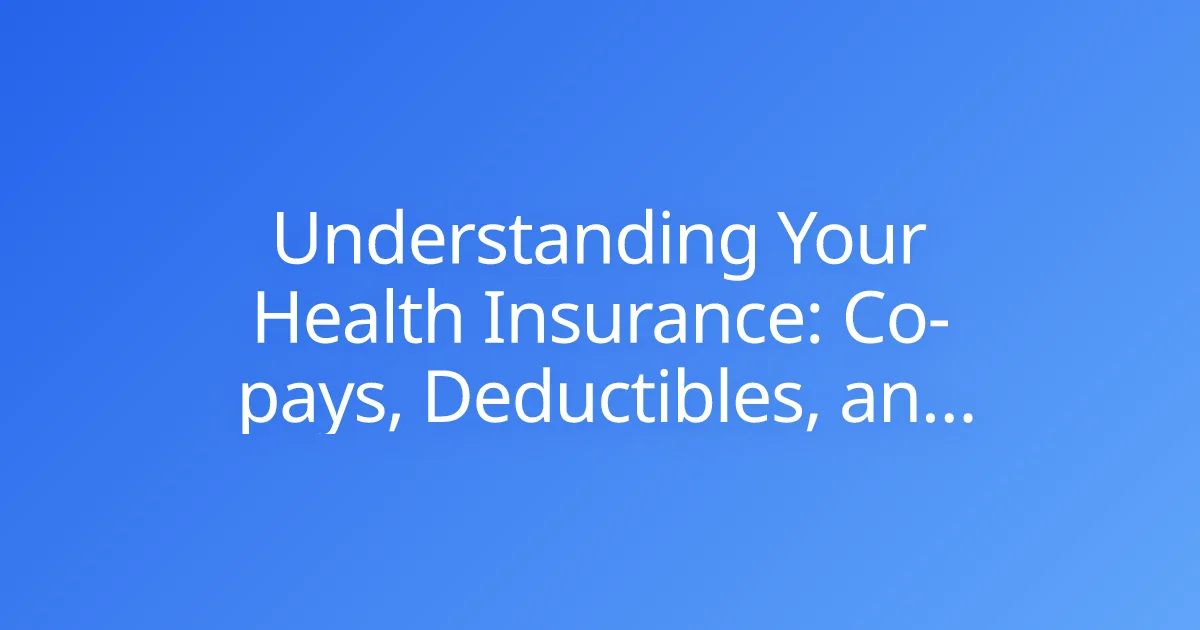Open Enrollment Period: Your Guide to Choosing or Changing Health Insurance
Each year, for a limited window of time, a crucial decision point arrives for millions: the Open Enrollment Period. For some, it's a chance to sign up for health insurance for the first time. For others, it's the only opportunity to evaluate, adjust, or completely change their existing healthcare coverage. Yet, this vital period often feels like a rush through a labyrinth of complex terms, confusing plan options, and pressing deadlines, leaving many feeling overwhelmed and unsure how to truly choose the right path. Missing this window or making an ill-informed choice can lead to significant financial burdens, limited access to care, or even coverage gaps for you and your family.
At The Policy Explainer, we recognize the importance of this annual decision. This comprehensive guide is designed to be your definitive resource for navigating the Open Enrollment Period. We will clarify what this period entails, why it's so critical, and provide a clear, step-by-step roadmap to empower you in choosing or changing your health insurance plan with confidence. Our goal is to ensure you secure the most beneficial and cost-effective coverage for your unique health needs and financial situation.
What is the Open Enrollment Period?
The Open Enrollment Period is the annual timeframe when individuals and families can enroll in, change, or re-enroll in a health insurance plan for the upcoming year. Outside of this period, you generally cannot buy or switch plans unless you qualify for a Special Enrollment Period.
Annual Opportunity
- Fixed Window: For most people, Open Enrollment typically occurs once a year, usually in the fall (e.g., November 1st to January 15th for plans through the Health Insurance Marketplace, though specific dates can vary by year and state).
- Guaranteed Coverage: During this period, health insurance companies cannot deny you coverage or charge you more based on pre-existing conditions.
- Key Decision Point: It's your prime opportunity to assess whether your current plan still meets your needs or if a new plan offers better benefits or lower costs.
Special Enrollment Periods (SEPs)
While Open Enrollment is the primary window, life happens. If you experience a "qualifying life event" outside of the regular Open Enrollment Period, you may be eligible for a Special Enrollment Period (SEP).
- Qualifying Life Events Examples:
- Losing existing health insurance coverage (e.g., due to job loss, turning 26, divorce).
- Changes in household size (e.g., getting married, having a baby, adopting a child).
- Moving to a new permanent address that changes your plan options.
- Changes in income that affect your eligibility for subsidies.
- Changes in citizenship status.
- Limited Time: Most SEPs last for 60 days from the date of the qualifying event, so it's crucial to act quickly.
Why is Open Enrollment So Important?
Treating Open Enrollment as a mere formality or skipping it entirely can have significant consequences. It's an active decision-making process that directly impacts your health and finances.
Reviewing Your Current Plan
Even if you're happy with your current health insurance plan, a review is essential.
- Annual Changes: Insurance companies often make changes to their plans annually, including adjustments to premiums, deductibles, co-pays, coinsurance, and most importantly, their provider networks and prescription drug formularies. Your current plan might not be the same next year.
- Provider Network Shifts: Your favorite doctor or specialist might leave your plan's network, or new providers might join.
Adapting to Life Changes
Your personal circumstances and those of your family can shift dramatically over a year.
- New Babies or Dependents: Adding children often means new healthcare needs and different cost-sharing considerations.
- Job Changes: A new job might offer different or no employer-sponsored coverage.
- Changes in Health Status: If your health has changed (e.g., developing a chronic condition, anticipating surgery), your current plan might no longer be the most cost-effective or beneficial.
- Financial Shifts: An increase or decrease in income can impact your eligibility for subsidies, making a different plan more affordable.
Exploring New Options
The health insurance market is dynamic. New plans, new benefits, or better pricing might become available.
- Competitive Landscape: Insurers may offer more competitive options to attract new members.
- Different Plan Types: You might find a different type of plan (e.g., switching from an HMO to a PPO) that better suits your evolving preferences for flexibility versus cost.
Avoiding Coverage Gaps
If you don't actively re-enroll or choose a new plan, you risk a gap in your health insurance coverage. While some plans might automatically re-enroll you, it's often into a plan that may not be optimal for you.
Key Steps to Successfully Navigate Open Enrollment
Approach Open Enrollment systematically to ensure you make the best choice.
Step 1: Review Your Current Health Needs and Usage
Start by assessing what you and your family needed and used in the past year, and what you anticipate for the upcoming year.
- Medical History: Note all doctor visits (PCP, specialist), hospital stays, emergency room visits, and procedures.
- Prescription Drugs: List all medications taken regularly, including dosages and costs.
- Preferred Providers: Identify any doctors, specialists, or hospitals you want to continue seeing.
- Anticipated Needs: Are you planning a family? Expecting surgery? Managing a new diagnosis?
Step 2: Understand Your Financial Picture
Healthcare costs involve more than just monthly premiums.
- Budget for Premiums: Determine how much you can comfortably afford to pay each month.
- Review Cost-Sharing (Deductibles, Co-pays, Coinsurance):
- Deductible: The amount you pay before your insurance starts contributing.
- Co-pays: Fixed fees for specific services (e.g., doctor visits, prescriptions).
- Coinsurance: The percentage of costs you pay after meeting your deductible.
- Out-of-Pocket Maximum: The most you'll pay for covered services in a year. This is your ultimate financial safeguard.
- Subsidy Eligibility: If purchasing through the Marketplace, check if your income qualifies you for premium tax credits or cost-sharing reductions, which can significantly lower your costs.
Step 3: Explore Available Plan Types
Familiarize yourself with the main types of health insurance plans and how they operate.
- HMO (Health Maintenance Organization): Lower premiums, restricted networks, often requires PCP referrals.
- PPO (Preferred Provider Organization): Higher premiums, broader networks, more flexibility (can go out-of-network for higher cost), no referrals needed.
- EPO (Exclusive Provider Organization): Network-restricted like an HMO, but typically no referrals needed for specialists within the network. No out-of-network coverage (except emergencies).
- POS (Point of Service): Hybrid of HMO/PPO, usually requires PCP, often requires referrals for in-network specialist care, but allows out-of-network options at a higher cost.
- HDHP (High-Deductible Health Plan) with HSA (Health Savings Account): Lower premiums but high deductibles, allows tax-advantaged savings for medical expenses.
Step 4: Check Provider Networks and Prescription Coverage
This step is critical for ensuring continuity of care and managing medication costs.
- Verify Doctor Inclusion: Use the plan's online provider directory or call your doctors' offices directly to confirm they are in the network for the specific plan you're considering.
- Check Hospital Affiliations: Ensure your preferred hospitals or specialists are covered.
- Review Formulary: If you take prescription drugs, check the plan's formulary (list of covered drugs) to confirm your medications are covered and at which cost tier.
Step 5: Compare Plans Side-by-Side (Costs & Benefits)
Once you've narrowed down your options, create a detailed comparison.
- Total Annual Cost: Estimate your total annual out-of-pocket costs for each plan by adding up premiums, expected co-pays, and a reasonable estimate for deductible/coinsurance based on your anticipated usage.
- Benefits: Compare what each plan offers beyond basic medical care (e.g., mental health services, dental/vision options, telehealth services, wellness programs).
- Out-of-Pocket Maximum: Pay close attention to this number, as it caps your financial exposure for the year.
Step 6: Enroll or Reconfirm Your Choice
Once you've made your decision:
- New Plan: Follow the enrollment instructions carefully.
- Existing Plan: If you're sticking with your current plan, ensure you understand any changes for the upcoming year. Many plans automatically re-enroll you, but it's always best to verify.
- Confirm Effective Date: Note when your new or re-enrolled coverage begins.
Common Mistakes to Avoid During Open Enrollment
Steer clear of these pitfalls to ensure a smooth and effective Open Enrollment experience.
Sticking with the Default Without Reviewing
Many people simply let their plan auto-renew. This is a common mistake because:
- Plan Changes: Your existing plan's benefits, network, and costs can change significantly from year to year.
- Your Needs Change: Your health or financial situation may have evolved, making a different plan a better fit.
Focusing Only on Premiums
While premiums are a major cost, they don't tell the whole story. A low-premium plan might have a very high deductible, high co-pays, or steep coinsurance, leading to much higher overall out-of-pocket costs if you need care.
Ignoring Network Restrictions
Choosing a plan without verifying if your preferred doctors are in-network can lead to unexpected out-of-network bills or the inconvenience of finding new providers.
Missing the Deadline
The Open Enrollment Period has strict deadlines. Missing it means you generally cannot enroll or change plans for the entire year unless you qualify for a Special Enrollment Period.
Not Understanding Your Out-of-Pocket Maximum
The out-of-pocket maximum is your financial safety net. Not knowing this figure can leave you unprepared for a large medical bill in a catastrophic health event.
What to Do If You Miss Open Enrollment?
If you miss the main Open Enrollment Period, your options become very limited, but there might still be hope.
Special Enrollment Period Eligibility
Check immediately if you qualify for a Special Enrollment Period due to a recent life event. If you do, you'll typically have 60 days from the event to enroll.
Short-Term Health Insurance
In some states, short-term health insurance plans are available. These plans are designed for temporary coverage (e.g., bridging a gap between jobs) and typically do not cover pre-existing conditions, essential health benefits, or preventive care as comprehensively as standard plans. They are not a long-term solution.
Medicaid & CHIP
If your income is low, you might be eligible for Medicaid (for adults) or the Children's Health Insurance Program (CHIP) for children and pregnant women. These programs have year-round enrollment.
Conclusion
The Open Enrollment Period is more than just an annual administrative task; it's a critical window of opportunity to actively manage your health insurance and secure your family's well-being and financial future. By taking the time to review your health needs, understand financial implications, explore plan types, verify networks, and compare options meticulously, you can confidently choose or change your health insurance plan. Making an informed decision during this time ensures you have the right healthcare coverage in place, providing invaluable peace of mind and robust protection against the uncertainties of life.
Do you have more questions about specific life events that might trigger a Special Enrollment Period, or need further clarification on plan benefits?



